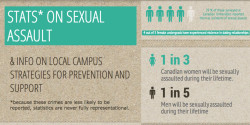Ottawa police have taken their investigation of a serial sexual offender public, urging people to consider the descriptions provided in an effort to identify a suspect.
Although police have only linked three cases by DNA, there is a possibility the perpetrator is connected to several other attacks, some of which have occurred in proximity to student housing areas and OC Transpo stations.
These incidents of violence, in addition to other recent assaults reported near or at campus events, have spurred fear among students.
The current situation is similar to one in 2007. At the time, posters—much like the composite sketches released by Ottawa police—were circulating Carleton University after a student was attacked, beaten and raped on campus.
It’s a time Julie Lalonde recalls vividly.
“On campus at that time, it was a pretty scary place. Everywhere you looked, there was this pencil drawing of this person, asking if we knew this person, or had we seen this person? … There was this heightened sense of fear on campus.”
It was early fall, a time known for its increased volume of sexual assaults on post-secondary campuses.
Lalonde, now with a movement to end street violence called Hollaback! Ottawa, became one of the founders of the coalition for a sexual assault center at Carleton. Six years later, the center is up and running and Ottawa police and campus responses to sexual assaults are evolving.
Although there is no direct connection between the development of campus-based support and education and the impacts it has on the city as a whole, Ottawa Coalition to End Violence Against Women is working on implementing citywide initiatives that bridge the gaps between campuses, and engage the community at large.
“Campus life is diverse, all campuses have different experiences and that should be recognized,” says Dillon Black, project coordinator at OCTEVAW.
During a community forum held by OCTEVAW at the University of Ottawa on Jan. 25, community and campus members discussed existing efforts, gaps in services and barriers they’re facing.
One of the trouble spots cited was the jurisdictional challenges faced when a sexual assault happens near campus, as opposed to on campus.
Abby Kidd, sexual assault outreach coordinator at the Carleton GSA, worries these incidents are then only seen as a city-based problem, as opposed to an attack that impacts campus life.
“This issue is not isolated to campus,” said Black.
Going forward, OCTEVAW will continue to consult with community members in the creation of their materials, but in the meantime the message is: When most sexual assault survivors are between the ages of 16 and 25, which is the age range of most students when they are enrolled in post-secondary, campus-based programming is available but is not your only option.
